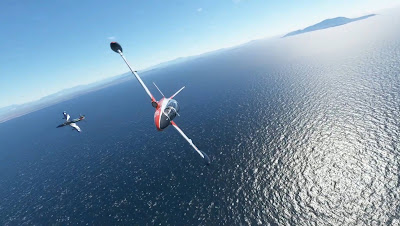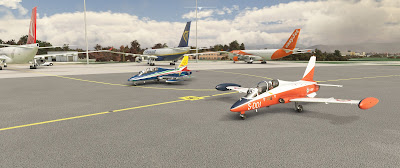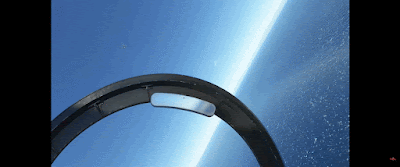After I got back to North Weald Airfield from my “Castles & Coasts” flight down to Dover, my taxi friend Ali drove me back to Epping Station and I caught a train for Cambridge, stopping for the night at Duxford, the site of another Imperial War Museum at Duxford Airfield, the biggest air museum in Europe.
My Tiger Moth lesson flight was set for 3 PM, but I entered the IWM at 11 AM on a beautiful, clear morning so I could explore the hangars and ramps brimming with historic airplanes. In the Air & Space hangar I found many favorite jets including the Vulcan bomber, the swing-wing Panavia Tornado, and the Concorde, which I walked through.
In and around the other hangars I found Spitfires, Hurricanes, a PBY Catalina, and a WWII twin-engine RAF Mosquito made mostly of wood, among many others! I walked into a hangar where workers were rearranging aircraft for the upcoming airshow. I wasn’t supposed to be in there, but I spotted an RAF Eurofighter Typhoon before they kicked me out.
In addition to all the amazing ground exhibits, several of
the flight performers for the weekend Duxford Airshow were rehearsing their
acts low over the runways. Practically a private airshow!
There was a great Battle of Britain exhibit with Spits and
Hurri’s and a crashed Messerschmitt Bf-109 in addition to a recreation of the control
rooms where they directed those epic aerial battles in 1940 using telephone and
radar reports, with a big map table where they pushed around markers to track friendly
and enemy aircraft positions.
I loved the American hangar where dozens of huge airplanes
were parked and hung from the ceiling, starting with the big iron – B-52, B-29,
B-24, and B-17 as well as all the major fighters from P-51 to F-15 and even the
Mach 3 SR-71 Blackbird.
Before my Tiger Moth lesson, I had also signed up for a 15
minute flight around the airfield in the Dragon Rapide, a small passenger
biplane from the late 1930’s. This was great because I got to take some good
aerial shots of Duxford which wasn’t possible in the Tiger Moth (no personal cameras). It was also very cool to taxi
out next to a Hurricane fighter!
Finally it was time for the 40 minute Tiger Moth lesson I
had booked months before. I had to empty my pockets for the open cockpit flight
(and to remove any competition for the in flight video they would later sell me).
I donned a leather helmet, headset, and goggles as well as a fleece-lined
leather jacket. I was strapped into the front seat, and after a radio check, we
took off on the grass and headed southwest.
Clear of the airport area, the pilot soon gave me the controls for the cruise and a few turns. The stick forces were amazingly light (the pilot was likely trimming for me), so “fly with two fingers” worked quite well. Instruments were minimal, and the forward view was obscured by the nose, so I used the left and right lower corners of the windscreen as reference points to keep the wings level with the horizon. Visibility was otherwise excellent, and I enjoyed the beautiful Cambridgeshire countryside from 1500-2000 feet. We flew over several towns including Royston, as well as the radio telescopes of the Millard Radio Astronomy Observatory, just 5 miles SW of central Cambridge.
After landing, exhausted from hours of walking around huge Duxford Airfield, I took a taxi into Cambridge and checked myself into my apartment hotel for the remainder of my stay. It was a great little flat although I wished I picked one a little closer to central Cambridge. I spent Friday morning exploring the excellent Fitzwilliam Museum, although I mainly visited the art galleries, including a special David Hockney exhibit.
I didn’t have time for the many galleries of Egyptian,
Greek, and other antiquities because I was keen to get to the pub for lunch and
a pint of DNA. Specifically, a pint of DNA Ale at the Eagle Pub, famous as the place
where James Watson and Francis Crick (above left) popped by from their nearby lab in
February 1953 to announce that they had discovered “the
secret of life,” otherwise known as the double-helix structure of the DNA
molecule. They were regulars so they shared the news at the pub prior to actual
publication.
After lunch I signed up for a “guided
punt” on the Cam River. This classic Cambridge experience takes you for a
couple of hours up and down the Cam, gliding serenely along the “backs of the
colleges” of Cambridge. The weather remained perfect, and our punter guide was quite
informative and funny as he related history and gossip from ancient up to
modern times.
By Friday evening, walking had become very hard, and I soon
found the reason – two enormous blisters on my big toes. Although I did my best
to treat them, it was clear that another 5–8-mile day at the airshow the next
day was not going to be feasible. I texted my regrets to the friend I’d planned
to meet there and spent Saturday relaxing and looking at pictures. It was cloudy and raining, but fortunately I had a kitchen and had bought some food and beer, so survival was not at
stake.
By Sunday and Monday my first aid and foot padding strategies allowed me to venture out with the help of buses and taxis to minimize my steps. I went out to eat and explored two small but historic museums. The Sedgwick Museum is one of the oldest in Cambridge with a focus on paleontology and geology. The museum also had an excellent exhibit on the life and scientific accomplishments of Charles Darwin. Always a Darwin fan, I really enjoyed this exhibit and all of the fossils and displays at the Sedgwick.
Finally, I spent an enjoyable couple of hours at the nearby Whipple Science History Museum which was dominated by my old specialty, optics. There were hundreds of telescopes and microscopes from various periods, as well as a fascinating collection of globes.
I recently read a brief biography, The Reluctant Mr. Darwin by David Quammen. In it, the author describes the various reasons that it took over 20 years from the voyage of the Beagle (1831-1836) to the publication of The Origin of Species (1859). A big chunk of that time was devoted to detailed studies of barnacles. Why? At the time, little was known about barnacles, and Darwin thought he might spend a year or so identifying and organizing barnacle species. This might aid his understanding of variation in characteristics between closely related species, as well as contribute to zoology. It turned out to be more complex than he imagined, taking eight years and four books to complete to his satisfaction. Barnacles are small so a microscope was his constant companion, and that very microscope is on display in the History of Science Museum (above).
My flight for Boston was Tuesday evening, June 21, and I planned to take a National Express bus from Cambridge directly to Heathrow. But I had forgotten about a planned rail strike that day, and when I went to book my ride, the only available seats were on the 5 AM bus, since rail travelers were using every available option to get to London. Oh well, I can kill ten hours at an airport.
But there was a further adventure in store when the bus failed to show. So I shared a two-hour taxi ride with three other Heathrow-bound travelers who were congenial and funny. It was a wonderful vacation, right down to the last near-disaster.


















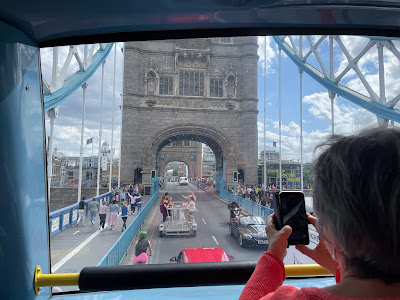









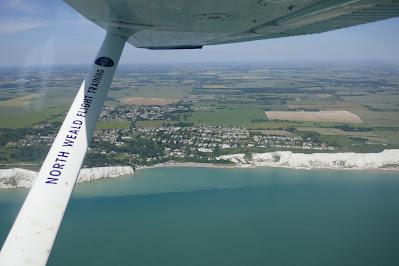


.jpg)
.jpg)

.jpg)
.jpg)
.jpg)
.jpg)
.jpg)
.jpg)
.jpg)
.jpg)

.jpg)
